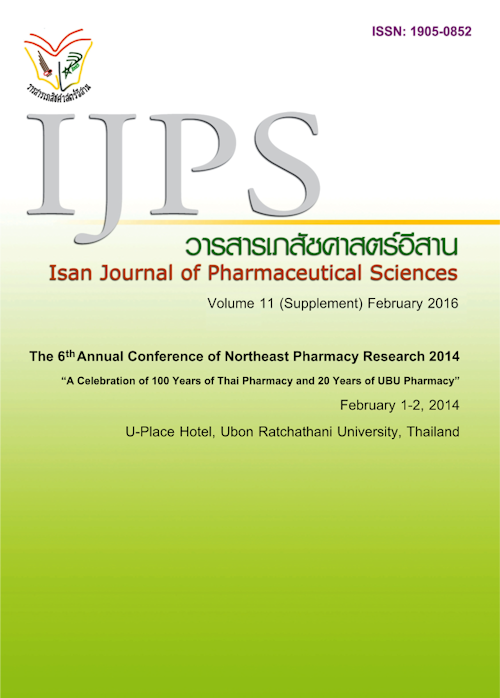Development and Evaluation of Pictorial Labeling System for Elderly Patients with Chronic disease
Main Article Content
Abstract
Introduction: The objective of this study was designed to develop and evaluate pictorial label for elderly patients with chronic diseases in Maha Sarakham province. Materials and method: The study was quasi experimental designed. The study samples were elderly patients with chronic diseases of Khamriang primary care hospital. The samples were divided into 2 groups including a control group receiving traditional labels and an experimental group receiving traditional and pictorial labels. Outcomes measured were 1) understanding, 2) accuracy drug use behavior score and 3) compliance. The study was conducted from June to November 2012. Results: There were 87 patients participated in the study. The experimental group (n=43) had score higher significantly than the control group (n=44) in 1) understanding (p = 0.027) 2) accuracy drug use behavior score (p = 0.025) and 3) compliance (p = 0.002). Conclusion: In conclusion, pictorial label can be used as an alternative method for improve efficacy of medication used in elderly patients with chronic diseases.
Article Details
In the case that some parts are used by others The author must Confirm that obtaining permission to use some of the original authors. And must attach evidence That the permission has been included
References
Chaijinda K, Nilaward K, Chuamanochan P, Awiphan R. Development and evaluation of pictorial labeling system for Northern Thai patients with low literate skills. [PhD thesis]. Chiang Mai: Chiang Mai University; 2007. [in Thai]
College of Population Studies, Chulalongkorn University. Number and percentage of elderly in Thailand1995-2010. [online [. 2010 [cited 2012 Aug10]. Availablefromhttp://www.cps.chula.ac.th/pop_info/thai/nop7/nop6/N6-WHOLE.htm. [in Thai]
Dowse R, Ehlers M. Medicine labels incorporating pictograms do they influence understanding and adherence? Patient EducCouns2005; 58: 63-70.
Dowse R, Ehlers M. The evaluation of pharmaceutical pictogramsinalow-literateSouthAfrican population. Patient EducCouns2001; 45: 87-99.
Education for all Global monitoring report. [online]. UNESCO 2006 [cited 2012 Aug 10]. Available from: http://www.unesco.org/new/en/education/themes/leading-the-international-agenda/efareport/reports/2006-literacy/
Ministry of Social Development and Human Security. Situation of Thai elderly 2004. [online]. 2010 [cited 2012 Aug 10]. Available from: http://www.m-society.go.th/document/edoc/edoc_893.pdf. [in Thai]
Ngoh N, Shepherd D. Design, development and evaluation of visual aid for communication prescription drug instruction to nonliterate patient in rural Cameroon. Patient EducCouns 1997; 30: 245-261.
Wongriantong T. Standard format of medicine labels in Thailand. [MSc Thesis]. Bangkok: Chulalongkorn University; 2007. [in Thai]


